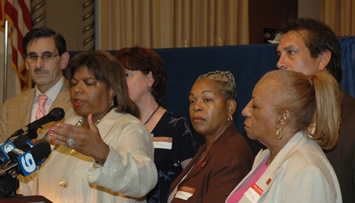CTU to reach Tentative Agreement by August 31st
On Wednesday, August 22nd CTU President Marilyn Stewart announced to the House of Delegates that the union had made a breakthrough in negotiations At the August 8, 2007 CTU meeting, CTU president Marylin Stewart (above at microphone) told the press she was fighting for a significant raise, respect for seniority, improvements in medical coverage, and other things for the Union's 32,000 members. By the August 22 meeting, many teachers were worried that she was closing her eyes to her previous promises. and reached a 'framework' for an agreement. Though both sides were still working out details, the union expects to have a tentative agreement by late next week.
At the August 8, 2007 CTU meeting, CTU president Marylin Stewart (above at microphone) told the press she was fighting for a significant raise, respect for seniority, improvements in medical coverage, and other things for the Union's 32,000 members. By the August 22 meeting, many teachers were worried that she was closing her eyes to her previous promises. and reached a 'framework' for an agreement. Though both sides were still working out details, the union expects to have a tentative agreement by late next week.
No details are available at this point—Stewart did not give any indication about the basis of the ‘framework.’ She did, however, tell delegates “to bring their reading glasses” and prepare for a long meeting on the 31st as delegates read and discuss the contract language contained in the tentative agreement.
The way the process works is that delegates read and debate the tentative agreement (TA), and either recommend the TA for a membership referendum (a system-wide vote which would be conducted at schools, likely within the first week or so of school) or reject the TA and send the leadership back to the bargaining table. Delegates have almost always approved such agreements—a TA has only been rejected once in the history of the union.
The August 22nd meeting marked a sharp contrast in tone from the August 8th meeting. Earlier in the summer, President Stewart agitated for more than an hour about the Board of Education’s mismanagement and intransigence. She spoke about the union facing three options—‘option two’ being a strike vote. Delegates continuously interrupted her combative speech with applause. On the 22nd she spoke quietly, rarely raising her voice. Even when she offered her opinion that “the talk of option two made them cave” delegates reacted by listening instead of cheering.
Several delegates came to the floor microphones with advice—‘don’t flinch,’ ‘bring us back a good contract,’ ‘don’t count an increase in the length of our work day as a raise.” But overall, the mood was more like sitting in a waiting room, hoping for word from a doctor than participating in a meeting of 800 rank and file leaders in the middle of tough negotiations with the board. One conclusion was clear—the leadership is not trying to mobilize the union—they have already settled.
Now we wait to see the terms of that settlement. The CTU is in a good position this year to make some real gains for teachers and schools--the budget is growing substantially, city officials are very focused on improving education, and the demands on teachers are increasing rapidly. The board may try give teachers a variation on the deal the other unions got—a 3% raise plus pay for extra time added to the school day; some health insurance fixes including a wellness program; finally we should see some job security protections. But will the tentative agreement address the growing non-union charters? Will it provide improvements to class size and working conditions? Will elementary teachers finally be guaranteed a prep period?
In the end, how much teachers get should depend more on the 32,000 members than the toughness and charisma of our leader, but we’ll have to wait and see.


